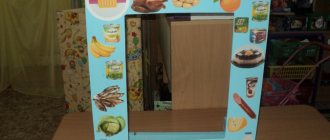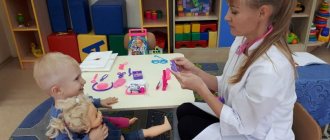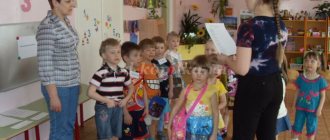Plot-role-playing game for preschoolers. article (senior group) on the topic
The structure of a plot-role-playing game.
A role-playing game has the following structural components: - plot;
- content;
— role [17].
Let's look at each of these structural components.
A) The plot of the game.
The main component of a role-playing game is the plot; without it, there is no role-playing game itself.
The plot is the sphere of reality that is reproduced by children. The plot is a child’s reflection of certain actions, events, relationships from the life and activities of those around him. At the same time, his playful actions (turning the steering wheel of a car, preparing lunch, teaching students how to draw, etc.) are one of the main means of realizing the plot.
The plots of the games are varied. They are conventionally divided into:
- household (family games, kindergarten);
- production ones, reflecting the professional work of people (games of hospital, store, livestock farm);
- public (games to celebrate the city’s birthday, to the library, to school, to fly to the moon) [8].
B) Game content. Changes in content depending on the age of the children.
The content of the game, notes D.B. Elkonin, is what is reproduced by the child as a central and characteristic moment of activity and relationships between adults in their everyday, work, and social activities [6].
Depending on the depth of the child’s ideas about the activities of adults, the content of the games also changes.
In terms of content, the games of children of primary preschool age differ from the games of older children. These differences are associated with the relative limitations of experience, features of the development of imagination, thinking, and speech. The child cannot imagine the game before it starts and does not grasp the logical sequence between real events [7]. Therefore, the content of the games, as A.P. Usova noted, is fragmentary and illogical. Children often repeat in play actions with toys shown by adults and related to everyday life: fed the bear - put him to bed; fed him again and put him to bed again. A.P. Usova characterized such games as action games [17].
However, at the border between the third and fourth years of life, games become more meaningful, which is associated with the expansion of children’s ideas about the world around them. Preschoolers begin to combine different events, including in games episodes from their own experience and from literary works that were read to them or, which is especially valuable, shown through plot-didactic games, illustrations in books, table theater, and filmstrips.
In the fourth and fifth years of life, the integrity of the plot and the interconnectedness of the reflected events are observed in children’s games. Preschoolers develop an interest in certain scenes that they have played with before (family, hospital, construction workers, transport, etc.). Children respond vividly to new experiences, weaving them like storylines into familiar games. The enrichment of content is facilitated by the interaction of children in the game, when everyone contributes something of their own, individual.
Children of senior preschool age thoughtfully approach the choice of plot, discuss it in advance, and plan the development of the content at an elementary level. New stories are appearing that are inspired by impressions gleaned outside the preschool: based on animated series, books read at home, stories from parents, etc.
In older and preschool age, generalization of play situations continues; in addition to conditional and symbolic actions (put his head on his palm - he fell asleep), children actively use verbal comments (“Everyone seems to have slept - and we’ll immediately go to the hall for the holiday!”; “Let’s do this: we’ve already arrived in Africa!”). These speech comments are a verbal replacement of any events [2]. Children resort to them so as not to violate the logic of the unfolding of the game’s content.
Thus, throughout preschool childhood, the development and complication of the content of the game is carried out in the following directions [1]:
- strengthening the purposefulness, and therefore the consistency and coherence of what is depicted;
- a gradual transition from an expanded game situation to a collapsed one, generalization of what is depicted in the game (the use of conditional and symbolic actions, verbal substitutions).
The variety of content of role-playing games is determined by children’s knowledge of those aspects of reality that are depicted in the game, the consonance of this knowledge with the interests, feelings of the child, and his personal experience. Finally, the development of the content of games depends on the child’s ability to identify characteristic features in the activities and relationships of adults.
B) Role in the game. Role changes as children age.
The content of the role-playing game is embodied by the child through the role he takes on. A role is a means of realizing the plot and the main component of a role-playing game [8].
For a child, a role is his playing position: he identifies himself with a character in the plot and acts in accordance with his ideas about this character. Every role contains its own rules of behavior, taken by the child from the surrounding life, borrowed from relationships in the adult world. Submission of the child to the rules of role-playing behavior is the most important element of role-playing play. Deviation of any of the players from these rules causes protests from the playing partners. Thus, for preschoolers, a role is an example of how to act. Based on this sample, the child evaluates the behavior of the participants in the game, and then his own.
Throughout preschool childhood, the development of role in role-playing games occurs from the performance of role-playing actions to role-images. For younger preschoolers, everyday activities predominate: cooking, bathing, washing, driving, etc. Then role designations associated with certain actions appear: I am a mother, I am a driver, I am a doctor.
In middle preschool age, playing a role becomes a significant motive for play activity: the child develops a desire not just to play, but to fulfill one or another role. The point of the game for a 4-5 year old preschooler is the relationships between the characters. Therefore, the child willingly takes on those roles in which the relationships are clear to him (the teacher takes care of the children, the captain steers the ship, makes sure that the sailors work well and that the passengers are comfortable). At this age, role speech becomes a means of interaction.
In older preschool age, the meaning of the game lies in the typical relationships of the person whose role is played by the child with other persons whose roles are taken on by other children. In games, role-playing dialogues appear, with the help of which the relationships between characters are expressed and game interaction is established. For the quality of role performance, the child’s attitude towards it is important. Therefore, it should be borne in mind that older preschoolers are reluctant to perform roles that, in their opinion, do not correspond to their gender. When performing a role, the child takes into account not so much the external logic, the sequence of actions (there is a free runway at the airfield, which means the plane can land), but the meaning of social relations (the runway is free, but you need to ask the dispatcher so that an accident does not happen).
Used Books .
1. Boychenko HA et al. Role-playing games for preschoolers. - Kyiv: Radyanska School, 1982.
2. Valitova I.E. Psychology of development of a preschool child. -Minsk, 1997
3. Zaporozhets A.V., Elkonin D.B. Psychology of preschool children. - M.: Mysl, 1989.
4. Zvorygina E.V. The first story-based games for kids. - M.: Radug
5.Kozlova S.A. Preschool pedagogy: a textbook for students / S.A. Kozlova, T.A. Kulikova. - M.: Publishing House, 2007. a, 1988.
6.Psychology and pedagogy of preschooler play. // Ed. A.V.Zaporozhets, A.P.Usova. - M.: Mysl, 1986.
Levels of development of role-playing games
First stage . The main content of the game is actions with objects. They are carried out in a certain sequence, although this sequence is often disrupted. The chain of actions is plot-based. The main subjects are everyday ones. Children's actions are monotonous and often repeated. Roles are not designated. In form it is a side-by-side game or a single player game. Children willingly play with adults. Independent play is short-lived. As a rule, the stimulus for the emergence of a game is a toy or a substitute object that was previously used in the game.
Second phase . The main content of the game is actions with an object. These actions unfold more fully and consistently in accordance with the role that is already denoted by the word. The sequence of actions becomes the rule. The first interaction between participants occurs based on the use of a common toy (or direction of action). Associations are short-lived. The main subjects are everyday ones. The same game can be repeated many times. Toys are not selected in advance, but children often use the same ones - their favorite ones. The game can already unite 2-3 people.
Third stage . The main content of the game is also actions with objects. However, they are complemented by actions aimed at establishing various contacts with playing partners. Roles are clearly defined and assigned before the game begins. Toys and objects are selected (most often during the game) in accordance with the role. Logics; the nature of actions and their direction are determined by the role. This becomes the basic rule. The game often proceeds as a joint game, although interaction is interspersed with parallel actions of partners who are not related to each other and are not correlated with the role. The duration of the game increases. The plots become more diverse: children reflect everyday life, the work of adults and vibrant social phenomena.
Fourth stage . The main content of the game is a reflection of the relationships and interactions of adults with each other. The themes of games can be varied: it is determined not only by the direct, but also by the indirect experience of children. Games are joint and collective in nature. Associations are stable. They are built either on children’s interest in the same games, or on the basis of personal sympathies and affections. Games of the same content are not only repeated for a long time, but also develop, become enriched, and exist for a long time.
In the game at this stage, the preparatory work is clearly distinguished: the distribution of roles, the selection of game material, and sometimes its production (homemade toys). The requirement to comply with the logic of life applies not only to actions, but also to all actions and role behavior of the participants. Up to 5-6 people are involved in the game.
The above levels reflect the general development of role-playing games, but in a specific age group adjacent levels coexist.
Based on the concept of N. Ya. Mikhailenko, the development of story-based play at different age stages can be presented in the following summary table.
| Age | Nature of game actions | Performing a role | Plot development in an imaginary situation |
| 3-4 goals | Separate game actions that are conditional in nature | The role is actually performed, but not named | The plot is a chain of two actions, the imaginary situation is held by an adult |
| 4-5 years | Interconnected game actions with a clear role-playing character | The role is called, children can change the role during the game | A chain of 3-4 interconnected actions, children independently hold an imaginary situation |
| 5-6 years | Transition to role-playing actions that reflect the social functions of people | Roles are assigned before the game starts, children stick to their role throughout the game | A chain of game actions, united by one plot, corresponding to the real logic of the actions of adults |
| 6-7 years | Representation of relationships between people (subordination, cooperation) in game actions. The technique of game actions is conventional | Not only the roles, but also the idea of the game are spoken out by the children before it begins. | The plot is based on an imaginary situation, the actions are varied and correspond to real relationships between people |
How are role-playing games beneficial for a child’s development?
The benefits of such activities are varied. They are as follows:
- creating communicative and speech experience;
- enable the child to act in conditions reminiscent of real situations;
- opening up the chance for exploration and experimentation;
- help to gain social skills from communicating with children and adults;
- by trying on an unusual role, the baby will better understand those around him;
- promote knowledge of different cultures, expression of thoughts and feelings in the most friendly atmosphere;
- provide an opportunity to learn better through entertainment;
- stimulate imagination and creative skills.
Role-playing games are one of the effective language learning techniques. During the course, the baby copies the phrases he hears and can also form his own sentences. This technique promotes the development of vocabulary and experience of communicating with other people.
Content and significance of role-playing games in preschool educational institutions
The content of a role-playing game is the play interaction and relationships between children.
The content of the role-playing game largely depends on the age of the children, that is, it is determined by the experience and knowledge of the children, the characteristics of their development and imagination, the development of thinking and speech.
The importance of role-playing games in preschool educational institutions:
- development of the child's personality;
- organization of a children's group;
- means of teaching and self-education for children;
- correction of children's development;
- child development diagnostic tool;
- psychotherapy.
Opportunities for role-playing games:
- Development of preschool children.
- Mental development of children.
- A form of modeling social relationships and roles in society.
Principles for organizing role-playing games by preschool teachers:
- a joint game between the teacher and children, where he plays a leading role (during the game, the teacher guides the children, distributes roles, gives hints, etc.);
- a game between the teacher and children, where the teacher plays a secondary role (the teacher, before starting the game, distributes roles based on the children’s capabilities);
- children’s game without a teacher (before the start of the game, the teacher determines the leader, negotiates roles and rules with him, and during the game the child controls the process).






